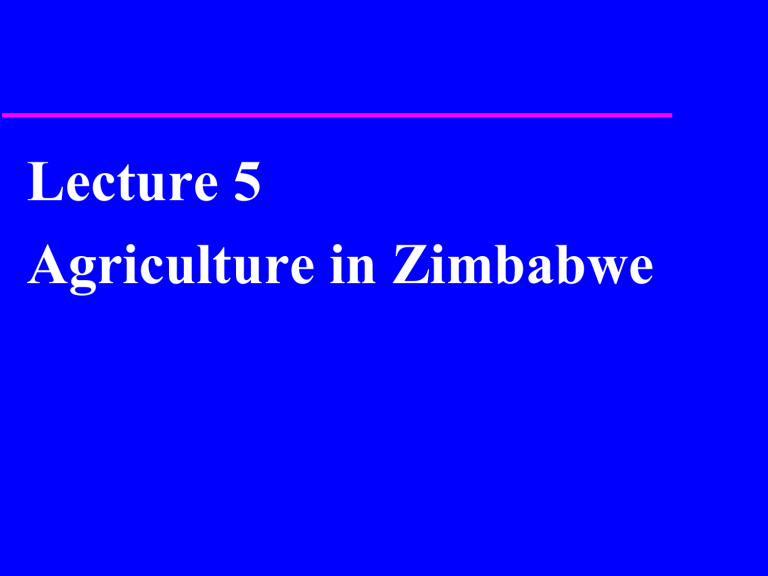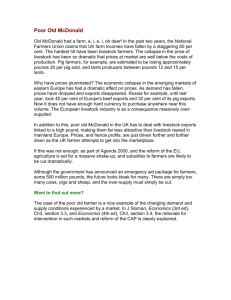
Lecture 5
Agriculture in Zimbabwe
National statistics: GDP growth
15
Percentage per annum
10
5
0
-5
-10
-15
1990 1992 1994 1996 1998 2000 2002 2004 2006 2008
National statistics
GDP
$7.366 billion (2013 est.)
GDP growth 4.4% (2012 est.)
GDP per capita $600 (2012 est.)
GDP by sector Agriculture: 20.3%,
Industry: 25.1%, Services: 54.6% (2012
est.)
GDP by sector
GDP by Sector, 1998-2010
(Million 2009 USD)
10000
8000
6000
4000
2000
0
Avg.1998-01
2008
Other
Manufacturing
2009
Mining
Agriculture
2010
Sectoral exports
Sectoral Exports (as %GDP)
25
20
15
10
5
0
2005
2006
Agricultural exports
2007
2008
Manufacturing exports
2009
Mining exports
2010
Importance of Agriculture to Zim
Agriculture occupies a central place in the
Zimbabwean economy,
It is the major source of food security for
the nation.
It is a major contributor to national income,
contributing 16-20% of GDP.
It contributes over 40% of national export
earnings
Importance of Agriculture to Zim
About
60% of raw materials for agroindustries come from agriculture
Over 70% of the population derives its
livelihood from the agriculture sector
directly and indirectly.
Agriculture -related formal employment
supports a third of the formal labour force
(GoZ, 2011).
Agricultural statistics
Indicator
Agricultural land (% of land area)
Arable land (hectares)
Arable land (% of land area)
Agriculture, value added (% of GDP)
Food exports (% of merchandise exports)
Food imports (% of merchandise imports)
Population, total
Agricultural population (% of total population)
Value
42.39
4,180,000
10.8
15.66
20.09
18.78
12,754,378
55.5
Year
2009
2009
2009
2011
2010
2010
2011
2011
Natural resource base
Production patterns in NR
NR1-
Plantations, fruits like bananas,
coffee, and tea, potatoes, peas and
vegetables, flowers- communal farmers
occupy only 20%, majority are plantations
NR11 – cover 75% of crop area, crops are
tobacco, maize soya beans, wheat and
horticultural crops. Irrigation is prevalent in
this area.
Production patterns in NR
NR11-
Beef production for exports
concentrated in this region and so is (was)
dairy, pig, poultry, crocodile and ostrich
production
Prior to land reform, communal farmers
occupied only 21%.
NR111- communal farmers occupied about
85% of land, with intensive production
Production patterns in NR
NR111-major
crops are maize, cotton
groundnuts, sunflower, tobacco (now
major), beef ranching
NR1V- Not naturally good for crop
production. However, smallholder farmers
grow small grains (sorghum, millet and
finger mille)
Commercial farmers do livestock
production
Production patterns in NR
NR1V-
smallholder farmers keep small
livestock like goats
NRV- cattle ranching mainly
Sugar cane production under irrigation,
especially in Chiredzi and Mwenezi
Massive citrus production
Game parks mostly found in these areas.
Farming systems prior 2000
Farming systems after 2000
Land category
Communal areas
Old resettlement
New resettlement:A1
New resettlement:A2
small scale commercial
large scale commercial
state farms
urban land
national parks & forests
Unallocated land
Area (million ha)
1980
2000
16.4
16.4
0
3.5
0
0
0
0
1.4
1.4
15.5
11.7
0.5
0.7
0.2
0.3
5.1
5.1
0
0
2010
16.4
3.5
4.1
3.5
1.4
3.4
0.7
0.3
5.1
0.7
Farming systems
commercial
sector, land was privately owned
(now all land is state land), production is for the
market and farms are run as commercial profitseeking enterprises.
Communal farmers, households do not have title
to the land they farm, much of the production
activity is family-based and subsistence
production remains an important part of
livelihood strategies.
Farming systems
The
model A1 is a villigised, self contained
or a three tier land use plan.
Model A2 is mainly small , medium and
large scale Commercial Settlement scheme
or Peri -Urban scheme
Agricultural production
Major agricultural commodities
Maize (food security)
Flue-cured tobacco (cash crop and forex)
Cotton (cash crop for Shh but no longer)
Sugar cane (local consump & forex)
Livestock (local cons and exports)
Horticulture (exports)
Area planted in 2010 and 2011
Areas Planted to Crops
2500
2000
1500
1000
500
0
Maize
Sorghum
Pearl Millet
2010 ('000 ha)
Tobacco
2011 ('000 ha)
Cotton
Groundnuts
Agricultural production (000 tonnes)
2 500
2 000
1 500
Maize
Small grains
Wheat
Tobacco
1 000
Horticulture
500
0
1994
2000
2005
2008
2009
2010
2011
2012
Agricultural production
Agricultural Output
Z$ (1990)
19
85
19
90
19
95
19
96
19
97
19
98
19
99
20
00
20
01
20
02
20
03
20
04
20
05
20
06
20
07
20
08
f
5500
• .
5000
4500
4000
3500
3000
2500
2000
1500
Maize production in the region
Maize produced
(tons; 2010)
South Africa
13,700,000
Malawi
2,943,000
Zambia
2,795,483
Mozambique*
1,932,000
Angola*
1,200,000
DRC*
1,200,000
Zimbabwe
1,175,000
Swaziland*
71,000
Namibia
53,000
Botswana
18,000
0
2,000,000
4,000,000
6,000,000
8,000,000
10,000,000
12,000,000
14,000,000
16,000,000
Maize production
Maize production (metric tons)
2,500,000
2,000,000
1,500,000
1,000,000
500,000
0
1994 1995 1996 1997 1998 1999 2000 2001 2002 2003 2004 2005 2006 2007 2008 2009 2010*
Maize productivity
Area of maize planted (ha)
Maize productivity (Kg per ha)
1,800
2,000,000
1,600
1,800,000
1,400
1,600,000
1,200
1,000
1,400,000
1,200,000
1,000,000
800
800,000
600
400
600,000
400,000
200
200,000
0
0
Tobacco
Volume of Tobacco Exports
(Price on the left axis)
250
6
5
200
4
150
3
100
2
50
1
0
0
1993 1994 1995 1996 1997 1998 1999 2000 2001 2002 2003 2004 2005 2006 2007 2008 2009 2010
Volume (m kgs)
Price (US$/kg)
Tobacco
The
improved profitability has attracted
more than 85,000 small-farmers in the
tobacco sector.
It is a crop whose production is on a
increasing trajectory
However production remains well below
(40% of) the previous peak achieved in
1999.
Cotton production
Zimbabwe
and Tanzania compete to be the
largest cotton sector in southern and eastern
Africa
The market for cotton is a pricing or market
system
Major markets are Asia, EU, local for seed
Cotton production
Production (000 bales)
700
600
500
400
300
200
100
0
Sugarcane production
Sugarcane
takes place under irrigation in
the lowveld.
The privately-owned estates, namely,
Triangle and Hippo Valley Estates
comprise 28,494 hectares of cane under
production and produce about 80 percent of
Zimbabwe’s sugar crop.
Private growers and newly resettled farmers
occupy about 15,880 hectares and produce
about 20 percent of the sugarcane crop.
Sugarcane production
The large estates have a potential to produce over three
million tons of sugarcane while private farmers and newly
resettled farmers have the potential to produce 1.4 million
tons of sugarcane, bringing the total sugarcane production
potential for Zimbabwe to about 4.4 million tons.
Markets are the SADC, EU and USA
1980
1981
1982
1983
1984
1985
1986
1987
1988
1989
1990
1991
1992
1993
1994
1995
1996
1997
1998
1999
2000
2001
2002
2003
2004
2005
2006
2007
2008
2009
2010
2011
2012
2013
2014
Sugarcane production
Cane Sugar Production (000mt)
700
600
500
400
300
Cane Sugar Production (000mt)
200
100
0
Livestock production
We
use the Livestock production index
(2004-2006 = 100)
The latest value for Livestock production
index (2004-2006 = 100) in Zimbabwe was
104.07 as of 2011. Over the past 50 years,
the value for this indicator has fluctuated
between 105.03 in 2009 and 41.57 in 1964.
Livestock production
Definition:
Livestock production index
includes meat and milk from all sources,
dairy products such as cheese, and eggs,
honey, raw silk, wool, and hides and skins.
Livestock index
Livestock index
106
104
102
100
98
Livestock index
96
94
92
90
88
2000
2001
2002
2003
2004
2005
2006
2007
2008
2009
2010
2011
Horticulture
Year
Mass in Tonnes
Estimated Value in US$ (thousands)
Flowers Produce Citrus
Flowers Produce Citrus
Total
2000
17,857
10,217
44,289
81,323
30,346
13,561 125,230
2001
21,749
9,955
45,840
78,297
26,341
14,510 119,148
2002
22,801
10,950
48,132
86,189
23,983
14,330 124,502
2003
20,171
10,236
47,767
72,616
25,179
14,221 112,016
2004
16,271
7,277
34,228
58,578
18,193
11,637 88,408
2005
14,327
4,553
26,311
51,576
11,383
8,946 71,905
2006
12,327
3,631
25,850
45,106
9,078
7,985 62,169
2007
10,420
3,445
24,730
36,470
8,640
7,591 52,701
2008
9,535
3,240
23,500
32,895
8,100
7,010 48,055
2009
7,670
2,800
23,670
26,078
6,810
7,260 40,148
2010
7,500
2,753
2,400
24,375
6,600
8,200 39,175
Horticulture exports trend
Total exports (000US$)
140 000
120 000
100 000
80 000
Total exports (000US$)
60 000
40 000
20 000
0
2000
2001
2002
2003
2004
2005
2006
2007
2008
2009
2010
Horticulture
Major
markets are EU and Middle East



